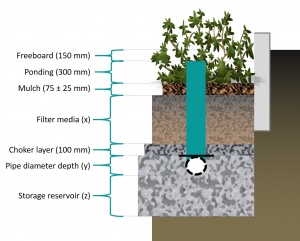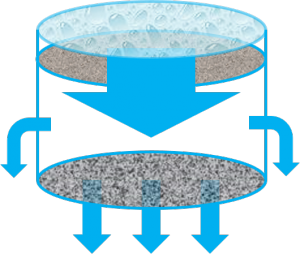Difference between revisions of "Bioretention: Sizing"
Jenny Hill (talk | contribs) m |
Jenny Hill (talk | contribs) m |
||
| Line 1: | Line 1: | ||
This article is specific to [[bioretention]], vegetated systems that infiltrate water to the native soil. <br> | This article is specific to [[bioretention]], vegetated systems that infiltrate water to the native soil. <br> | ||
| − | If you are designing a planted system which does not infiltrate water, see advice on [[ | + | If you are designing a planted system which does not infiltrate water, see advice on [[Planters: Sizing]]. |
[[File:Sizing Bioretention.jpg|thumb|The vertical storage zones in a bioretention cell include: ponding, mulch, filter media, choker course, pipe diameter reservoir and the storage reservoir.]] | [[File:Sizing Bioretention.jpg|thumb|The vertical storage zones in a bioretention cell include: ponding, mulch, filter media, choker course, pipe diameter reservoir and the storage reservoir.]] | ||
{{TOClimit|2}} | {{TOClimit|2}} | ||
Revision as of 19:31, 20 February 2018
This article is specific to bioretention, vegetated systems that infiltrate water to the native soil.
If you are designing a planted system which does not infiltrate water, see advice on Planters: Sizing.
Many of the dimensions in a bioretention system can be predetermined according to the function of the component. There is greatest flexibility in the ponding depth and the depth of the storage reservoir beneath the optional underdrain pipe. The order of operations in calculating these dimensions depends on whether an underdrain is desired.
| Component | Recommended depth (with underdrain pipe) | Recommended depth (no underdrain pipe) | Typical void ratio (Vr) |
|---|---|---|---|
| Ponding depth | 300 mm | See below | 1 |
| Mulch | 75 ± 25 mm |
| |
| Bioretention media |
|
0.3 | |
| Choker course | 100 mm | 0.4 typical | |
| Pipe diameter reservoir | Is equal to underdrain pipe diameter | Not applicable | 0.4 |
| Storage reservoir | See below | See below | 0.4 |
Calculate the maximum overall depth[edit]
- Step 1: Determine what the planting needs are and assign appropriate depth of media, using the table above.
- Step 2: Select an underdrain pipe diameter (typically 100 - 200 mm), assign this as an 'embedding' depth.
- Step 3: Calculate the maximum possible storage reservoir depth beneath the pipe (ds):
Where:
- f' = Design infiltration rate in mm/hr, and
- 38.4 comes from multiplying desired drainage time of 96 hours by void ratio of 0.4
Additional step for system without underdrain[edit]
- Step 4: Determine maximum permissible ponding depth (dp):
Where:
- f' = Design infiltration rate in mm/hr, and
- 19.2 comes from multiplying desired drainage time of 48 hours by void ratio of 0.4. Note that conceptually the drainage of the ponded area is limited by ex-filtration at the base of the practice.
- Step 5: Sum total depth of bioretention, and compare to available space above water table and bedrock. Adjust if necessary.
Calculate the remaining dimensions[edit]
- Step 6: Multiply the depth of each separate component by the void ratio and then sum the total to find the 1 dimensional storage (in mm).
- Step 7: Calculate the required total storage (m3):
Where:
- RVCT is the Runoff volume control target (mm),
- Ac is the catchment area (Ha),
- C is the runoff coefficient of the catchment area, and
- 0.1 is the units correction between m3 and mm.Ha.
- Step 8. Divide required storage (m3) by the 1 dimensional storage (in m) to find the required footprint area (Ap) for the bioretention in m2.
- Step 9. Calculate the peak flow rate (Qp, in L/s) through the filter media:
Where:
- Ksat is the saturated hydraulic conductivity of the filter media (mm/hr), and
- Ap is the area of the practice (m2).
Additional calculations[edit]
Fit the bioretention facility into the site plan. It is necessary to have an idea of the perimeter of the facility.
Narrow, linear cells drain faster than round or blocky footprint geometries.
Divide the area of the practice (Ap) by the perimeter (P).
Step 3, depth of bowl,db[edit]
The 'bowl' area is simply the depressed elevation of the surface compared to the surrounding areas; a space to permit temporary ponding.
The depth of the bowl would not typically exceed 0.5 m due to safety concerns.
Some jurisdictions or particular sites may demand a lower maximum depth of ponding. It is worth bearing in mind that in most cases this ponded water will only occur once or twice per year.
The ponded water within the bowl should drain within 48 hrs. This addresses public concerns about mosquitoes and reduces the probability of losing vegetation due to saturated growing conditions.
The drainage of the bowl is not usually constrained by the surface infiltration (filter media should drain > 25 mm/hr). The infiltration of water from the bowl is determined by the drainage of the filter media and reservoir into the soils.
To estimate the time (t) to fully drain the facility:
Groundwater mounding[edit]
When you wish to model the extent of groundwater mounding beneath an infiltration facility. This tool uses Hantush's derivation (1967).
Note that this is a minor adaptation (metric units and formatting) from the original tool, written and hosted by the USGS.







![{\displaystyle t={\frac {V_{R}A_{p}}{f'P}}ln\left[{\frac {\left(d+{\frac {A_{p}}{P}}\right)}{\left({\frac {A_{p}}{P}}\right)}}\right]}](https://wikimedia.org/api/rest_v1/media/math/render/svg/a9776616060d3374e3f396538eb88735772689c5)